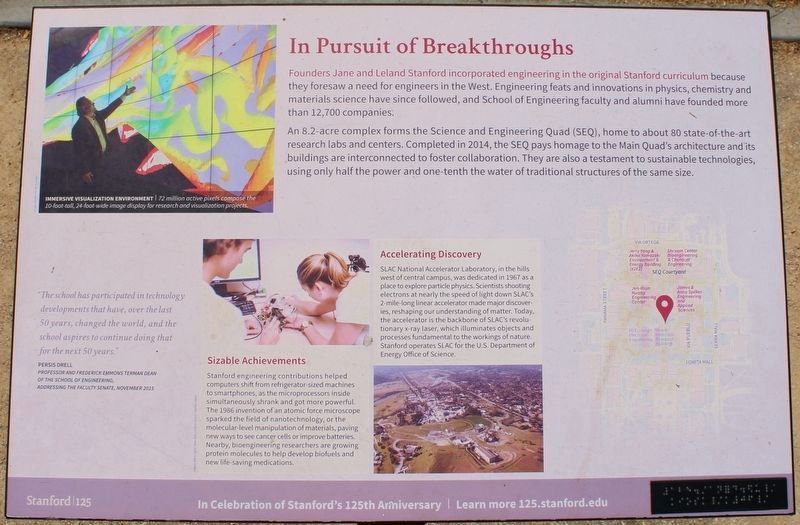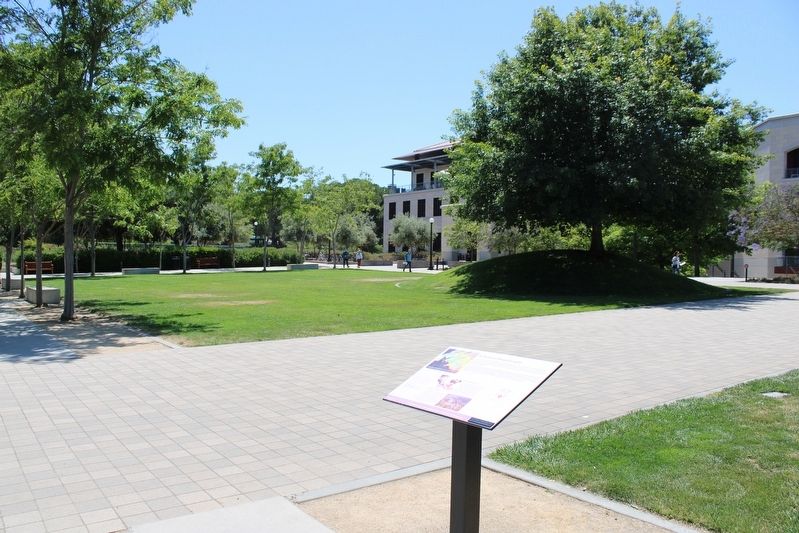Science & Engineering Quad Courtyard in Stanford in Santa Clara County, California — The American West (Pacific Coastal)
In Pursuit of Breakthroughs
An 8.2-acre complex forms the Science and Engineering Quad (SEQ), home to about 80 state-of-the-art research labs and centers. Completed in 2014, the SEQ pays homage to the Main Quad's architecture and its buildings are interconnected to foster collaboration. They are also a testament to sustainable technologies, using only half the power and one-tenth the water of traditional structures of the same size.
"The school has participated in technology developments that have, over the last 50 years, changed the world, and the school aspires to continue doing that for the next 50 years."
Persis Drell, Professor and Frederick Emmons Terman Dean of the School of Engineering, addressing the faculty senate, November 2015
Sizable Achievements
Stanford engineering contributions helped computers shift from refrigerator-sized machines to smartphones, as the microprocessors inside simultaneously shrank and got more powerful. The 1986 invention of an atomic force microscope sparked the field of nanotechnology, or the molecular-level manipulation of materials, paving new ways to see cancer cells or improve batteries. Nearby, bioengineering researchers are growing protein molecules to help develop biofuels and new life-saving medications.
Accelerating Discovery
SLAC National Accelerator Laboratory, in the hills west of central campus, was dedicated in 1967 as a place to explore particle physics. Scientists shooting electrons at nearly the speed of light down SLAC's 2-mile-long linear accelerator made major discoveries, reshaping our understanding of matter. Today, the accelerator is the backbone of SLAC's revolutionary x-ray laser, which illuminates objects and processes fundamental to the workings of nature. Stanford operates SLAC for the U.S. Department of Energy Office of Science.
In Celebration of Stanford's 125th Anniversary | Learn more 125.stanford.edu
Erected by Stanford University.
Topics. This historical marker is listed in these topic lists: Education • Science & Medicine. A significant historical year for this entry is 1967.
Location. 37° 25.689′ N, 122° 10.392′ W. Marker is in Stanford, California, in Santa Clara County. It is in Science & Engineering Quad Courtyard. Marker is on North-South Axis south of Via Pueblo, on the left when traveling south. The resin marker is mounted to a metal post west of the Physics & Astrophysics Building. Touch for map. Marker is at or near this postal address: 450 Jane Stanford Way, Stanford CA 94305, United States of America. Touch for directions.
Other nearby markers. At least 8 other markers are within walking distance of this marker. Exploring the Forces of Nature (about 500 feet away, measured in a direct line); Motion Picture Research Commemoration (approx. 0.2 miles away); Restoration of the Stanford Campus (approx. 0.2 miles away); The Burghers of Calais (approx. 0.2 miles away); James Grant Fergusson (approx. 0.2 miles away); Robert Edouard Pellissier (approx. 0.2 miles away); Nourishing the Whole Student (approx. 0.2 miles away); Wallenberg Hall (approx. ¼ mile away). Touch for a list and map of all markers in Stanford.
More about this marker. Inset Image:
Immersive Visualization Environment | 72 million active pixels compose the 10-foot-tall, 24-foot-wide image display for research and visualization projects.
Also see . . . A history of Stanford.
"When Jane Lathrop Stanford and railroad magnate and former California Gov. Leland Stanford lost their only child, Leland, Jr., to typhoid in 1884, they decided to build a university as the most fitting memorial, and deeded to it a large fortune that included the 8,180-acre Palo Alto stock farm that became the campus. They made their plans just as the modern research university was taking form."(Submitted on September 1, 2023, by Joseph Alvarado of Livermore, California.)
Credits. This page was last revised on September 1, 2023. It was originally submitted on September 1, 2023, by Joseph Alvarado of Livermore, California. This page has been viewed 70 times since then and 11 times this year. Photos: 1, 2. submitted on September 1, 2023, by Joseph Alvarado of Livermore, California.

